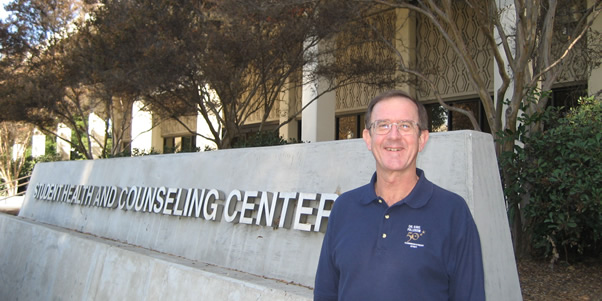CSUF and the H1N1 Flu
Q&A With Medical Director Richard Boucher
December 1, 2009
By Valerie Orleans
You hear about it in the media. You see posters on campus detailing how to cover your cough. There are hand sanitizers posted in several campus doorways.
All because of the H1N1 virus.
So, what should faculty and staff members and students at Cal State Fullerton know about H1N1? For answers, we turned to Richard Boucher, medical director of the university's Student Health and Counseling Center.
Q: Are students considered at greater risk of developing complications from H1N1 than the general public?
They might be. The Center for Disease Control has gone back and forth on the age limits of who is most at risk. At first, it was individuals up to age 18, then up to age 24, then back to 18. Now, it’s 24 again. Of course, the highest priority goes to pregnant women, then young children.
Q: Does the Health Center have the H1N1 vaccine?
We received an initial dose of 100, which went to health care center staff and university police. These are considered “first responders” and public health agencies are especially concerned that these people — who are vital links in helping those with the flu — not be stricken themselves.
Like everyone else, we probably won’t get enough vaccines for everyone. I’d encourage our faculty, staff and students to try to get vaccinated by their private family physicians.
Q: If you do get more vaccine, how will you decide who receives it?
Our first priority is students. We’d probably focus on nursing students because they will be helping student health services in providing vaccinations to other students. After this group, it would be students in student housing because they live in close quarters, usually with two people sharing a bedroom, and four to six students in a suite.
The next group would be athletic teams because they travel and train together. After them, we’d probably look at students in programs where they may come in close contact with young children, such as those in teacher education and child development.
Others who would be considered priorities would be student parents of children at our Children’s Center and pregnant students (with a note from their physician). Another possible priority group would be students living off campus in fraternities and sororities.
Q: If a pregnant student wants an H1N1 vaccination, would she be able to receive it here?
I’d encourage her to receive it from her obstetrician but I understand that many of them don’t have the vaccine. I’d need a note from her obstetrician stating that she should be vaccinated. Without having access to her medical records, I wouldn’t know if there were potential problems that could result if she were vaccinated. And again, we don’t know if we’ll be getting more vaccine or not. At this point, we don’t have any.
Q: Some campuses have held clinics where hundreds get vaccinated. Will that happen at Fullerton?
We first need to get an additional shipment of vaccine. We have requested 10,000 dosages. If the number we receive is high enough to run a clinic, we can do so. We would coordinate the effort with the Titan Student Union. Our nursing department would administer the vaccine. Also, the health sciences clubs would be asked to participate on the front end to help with patient registration. The health center would have a physician on site to answer any questions and handle any medical problems.
Q: Are you seeing increases in students with H1N1?
At this point, we’re just starting to enter what is referred to as flu season. Seasonal flu (not H1N1) tends to hit in December and January and run through February. We’re guessing H1N1 will follow a similar pattern with the peak hitting in January.
Last week, we saw 435 patients. Of those, 14 had flu-like symptoms. That’s a little high for this time of year. At this point, we are no longer testing for H1N1. By the time we get the lab results — usually in 10 days — the students are usually feeling better. Instead, we treat all flu cases as if they are H1N1.
Q: What are the symptoms of H1N1?
It usually comes on pretty fast — within three to six hours. However, individuals are contagious 24 hours before they show symptoms. Common signs include body aches, chills, fever, headaches and coughing. There’s a chart on the university's H1N1 site that differentiates between colds, seasonal flu and H1N1.
Q: What should you do if you develop these symptoms?
For starters, STAY HOME. You don’t want to spread the disease. Drink plenty of fluids and take ibuprofen, acetaminophen, Advil or Aleve. I don’t recommend aspirin, especially among children. Stay in bed and rest as much as you can. That said, if you experience chest pain, shortness of breath, high fever or disorientation, you want to be seen by medical professionals because there is a chance you could develop pneumonia or more serious complications.
Q: What about Tamiflu?
Tamiflu can be used to treat the H1N1 infection but this is reserved for those who are severely ill and/or have additional medical conditions that put them at higher risk. It should be started within 48 hours of symptoms though this timeline is a little more flexible right now. The use of ibuprofen is for symptomatic treatment.
Q: What if you can’t get the vaccination? How do you stay healthy?
There’s no 100 percent guarantee but we recommend coughing and sneezing into your elbow, not your hand. Wash your hands frequently with soap and warm water or use hand sanitizer if soap and water aren’t available. Also, avoid touching your eyes, mouth or nose if you haven’t washed your hands.
We’ll also need to encourage those who are sick to stay home. While it may be admirable to want to complete a project or assignment, it isn’t admirable to possibly contaminate your entire work team or classroom.


